How To Grow And Care For Periwinkle
This shiny green ground cover can fill in your planting beds, around trees, and more.
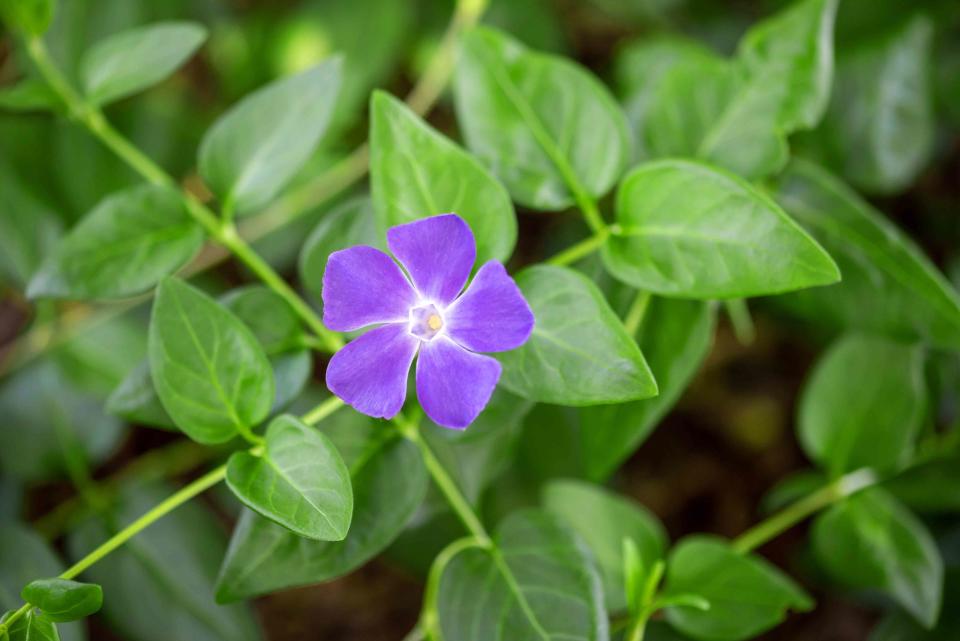
Vlasova Evgeniya, Southern Living
With trailing, arching stems that root where they touch soil, periwinkle plants grow as ground and bank covers. They feature shiny, dark green oval leaves and lavender-blue, five-petaled, pinwheel-shaped flowers that appear in leaf joints in early spring.
Periwinkle makes a great choice to plant around trees as it can successfully compete with surface tree roots. However, some varieties of vinca can be aggressive and spread rapidly, especially when planted in deep shade. Since it is considered invasive, some states call for moderate management of the plant.
Here is what to know about growing and caring for periwinkle.
Plant Attributes
Common Name | Vinca minor, common periwinkle, dwarf periwinkle |
Botanical Name | Vinca minor |
Family | Apocynaceae/dogbane |
Plant Type | Perennial |
Mature Size | 3-6 in. tall with trailing vines that grow up to 18 in. long |
Sun Exposure | Full, partial, shade |
Soil Type | Loamy, sandy, clay |
Soil pH | Choose from acidic, neutral, alkaline |
Bloom Time | Spring, summer |
Flower Color | Blue, purple, white |
Hardiness Zones | Choose from Zones 4-9 (USDA) |
Native Area | Europe |
Toxicity | Toxic to dogs and cats |

Vlasova Evgeniya, Southern Living
Periwinkle Care
This plant doesn't require a green thumb to maintain. It's pretty hardy and thrives in various environments. This low growing groundcover creeps along, putting down roots everywhere it touches dirt. You won’t find a more reliable groundcover for bare spots or to grow under trees. In addition to filling out your garden beds with lush, green leaves, it’s a good choice for difficult landscape situations such as hills, slopes, and places susceptible to erosion.
Plant soil-tolerant periwinkle’s larger species and its selections 2 to 21/2 feet apart; dwarf varieties should be planted 1 1/2 feet apart. When the plants mound up or become layered with old stems, shear before new spring growth begins.
Deer don't care for periwinkles. Periwinkle is toxic to dogs and cats.
Light
Periwinkle grows well in low light situations, including part sun, part shade, and full shade. When planted in full sun, periwinkle can scorch.
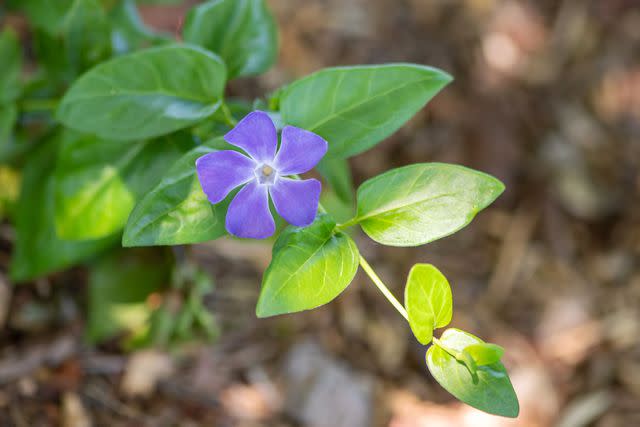
Vlasova Evgeniya, Southern Living
Soil
Periwinkle adapts to most soil environments, but to start growing this plant, add some organic peat moss or compost mixture to help improve soil drainage and nutrients.
Water
When first planting your periwinkle, water until the roots are well-established. Continue to keep it well-watered by maintaining moist but well-drained soil. Apply water to the roots instead of the entire plant. It helps to water earlier in the day to allow the afternoon sun to dry the vine's leaves and prevent disease or mold from forming. Periwinkle will be relatively drought-tolerant once fully established, but it does like the moist soil generally found in shaded and partially shaded areas.
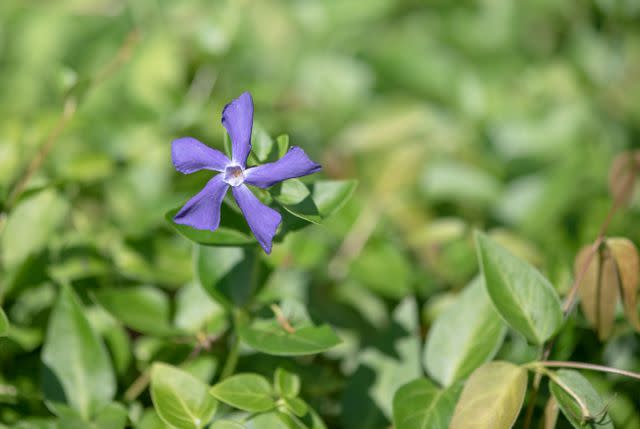
Vlasova Evgeniya, Southern Living
Types of Periwinkle
Greater Periwinkle (Vinca Major) grows in Zones 7-9 (USDA) in MS, LS, CS. This is a larger, more aggressive species. Leaves grow to 3 inches long and blooms purple flowers to 2 inches across; mounds to 12 feet high. Vinca major spreads rapidly and can be invasive in sheltered, shady areas.
'Variegata,' probably as common as the green form, has leaves strongly edged in white.
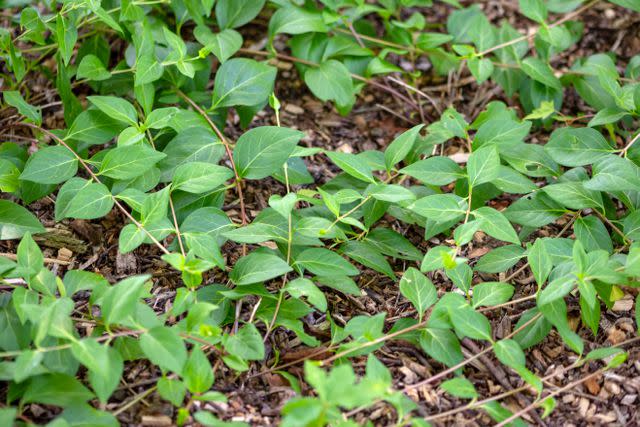
Vlasova Evgeniya, Southern Living
Common Periwinkle, Dwarf Periwinkle (Vinca Minor) grows in Zones 6-9 (USDA) in US, MS, LS, and CS gardens. This miniature version of Vinca major with ¾ to 1 ¾ inch long leaves and flowers that bloom an inch wide. More restrained, less likely to invade adjacent plantings.
Atropurpurea, deep purple flowers, small leaves; 'Illumination', bright gold leaves edge in green, blue flowers.
'La Grave' ('Bowles' Variety'), deeper blue flowers, larger leaves.
'Ralph Shugert', white-edged leaves, blue flowers, repeat autumn bloom.
'Sterling Silver', blue flowers, white-edged leaves speckled with pale green.
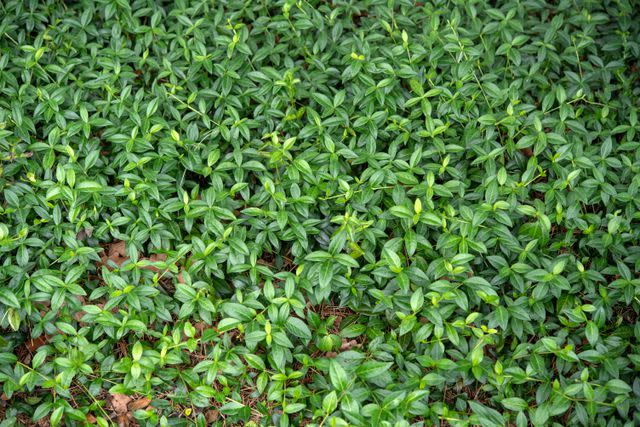
Vlasova Evgeniya, Southern Living
Pruning
When the plants mound up or become layered with old stems, mow or shear before new spring growth begins.
Propagating Periwinkle
Because it grows so well, periwinkle is a good plant to dig and divide rather than attempt propagation with a stem cutting. To divide, follow these steps.
Dig around a plant. You won’ have to go too far because they don’t root deeply.
Remove the plant from the soil.
Dig a planting bed about the same size and depth as the plant you dug up so that it matches its previous growing environment.
Tap down the soil.
Water well to start, then water consistently until the plant is established.
For more Southern Living news, make sure to sign up for our newsletter!
Read the original article on Southern Living.

